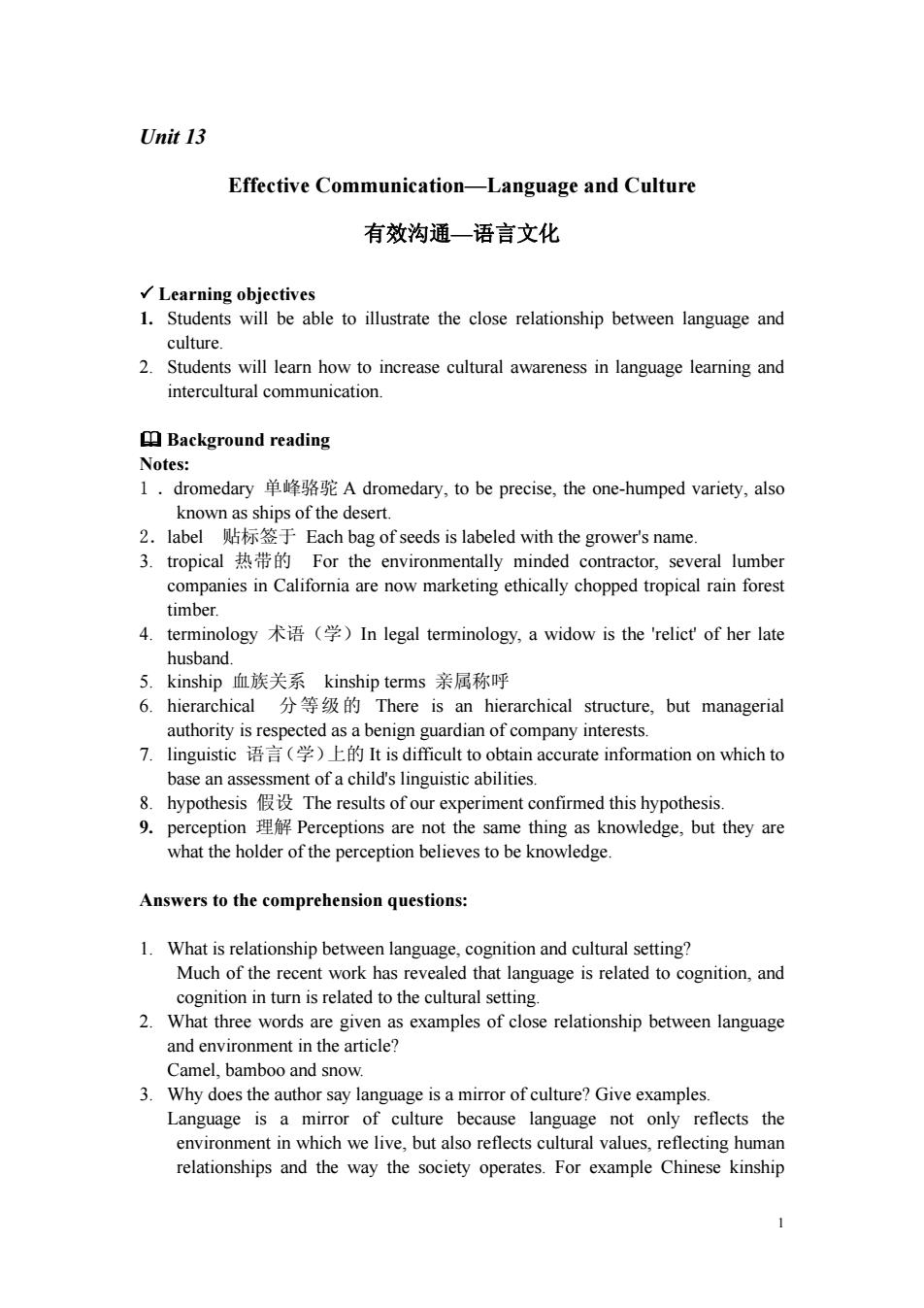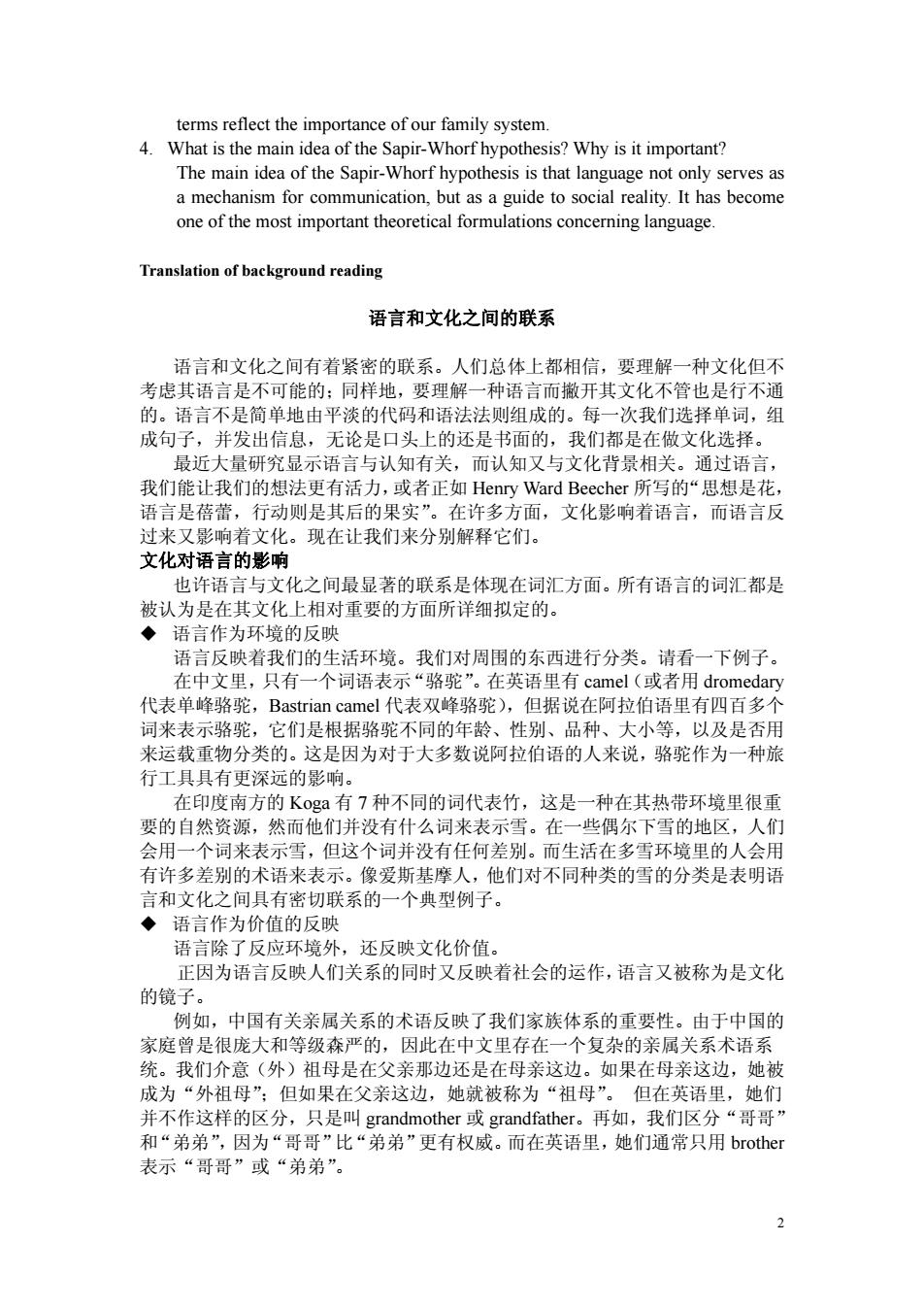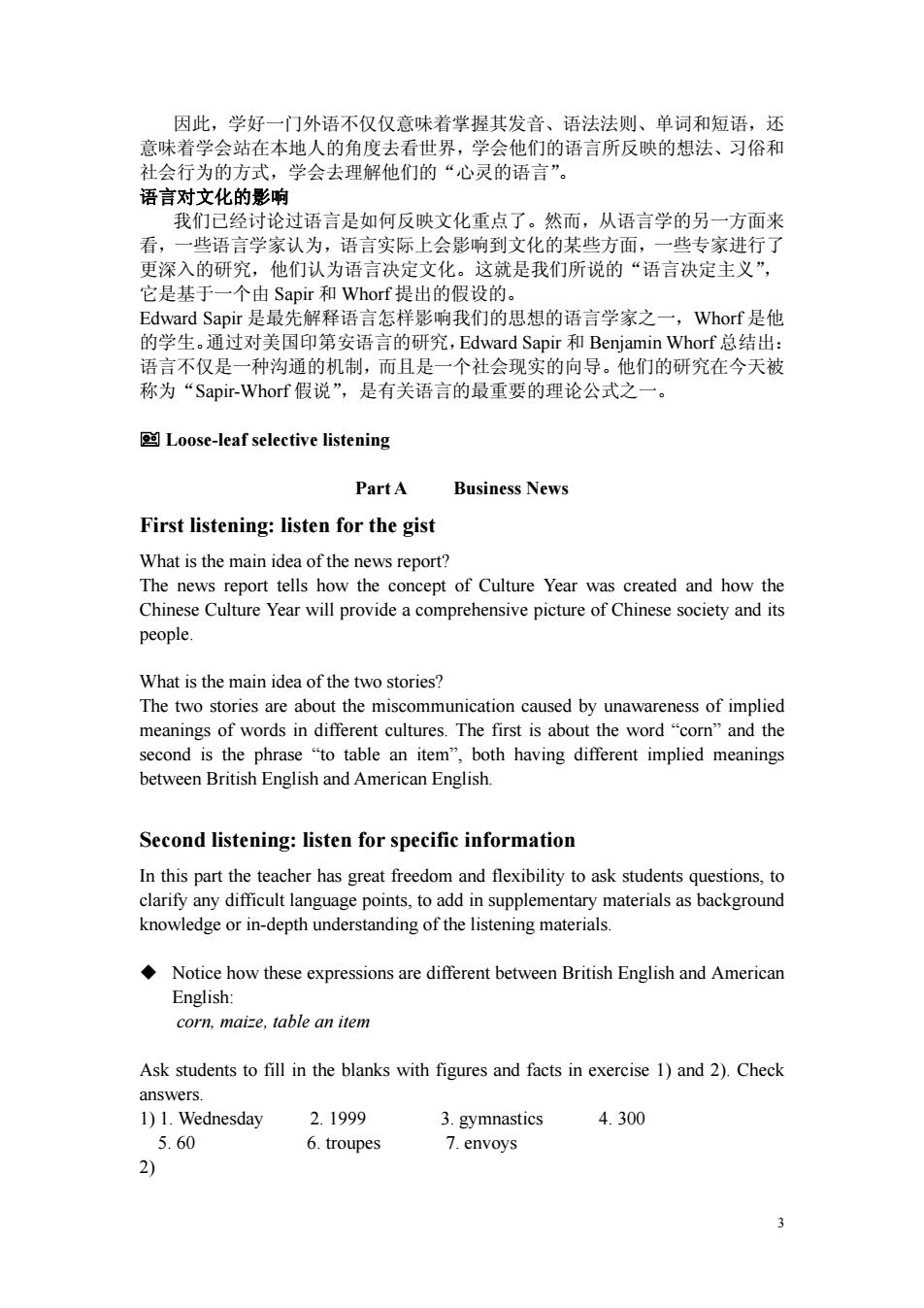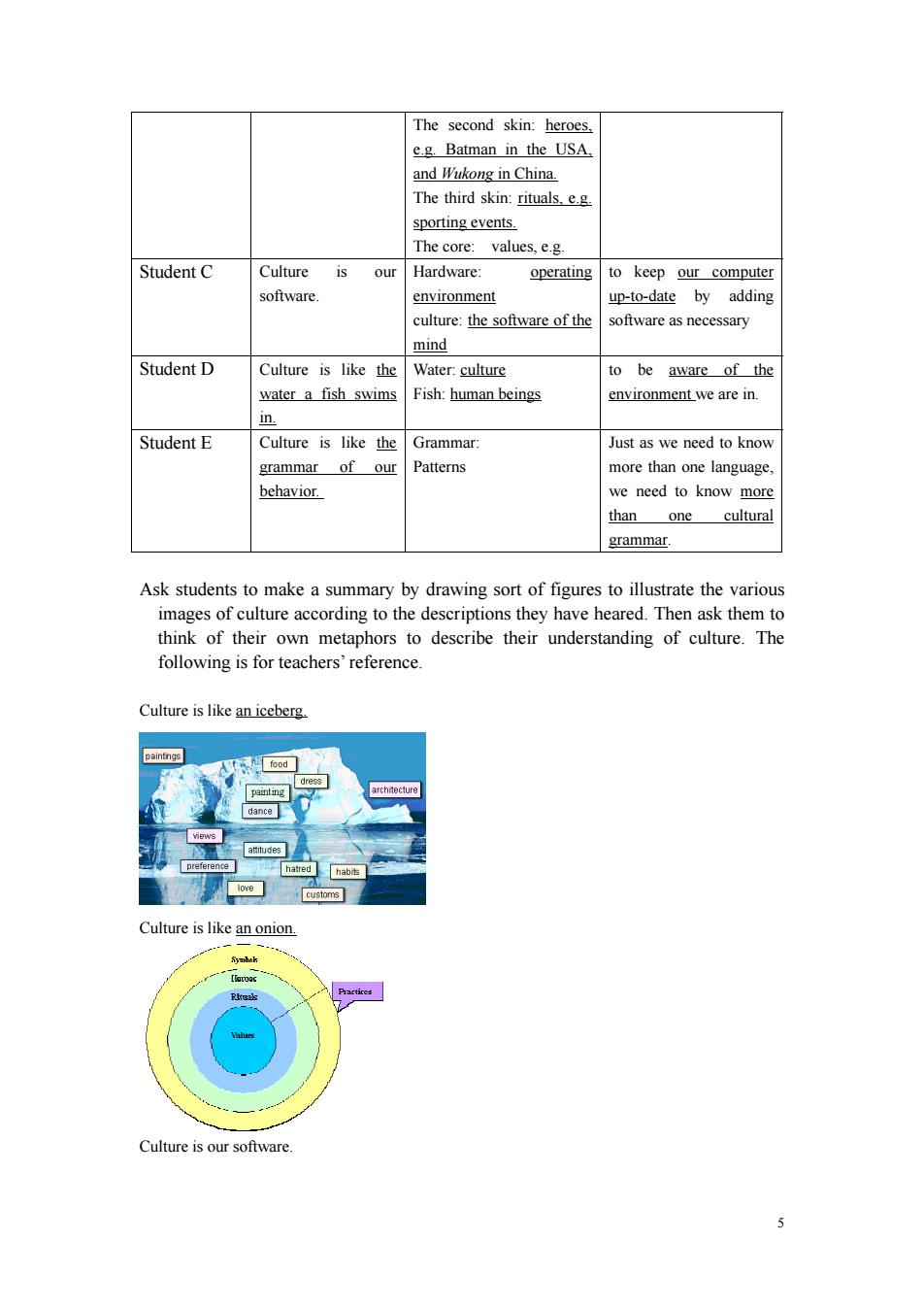
Unit 13 Effective Communication-Language and Culture 有效沟通一语言文化 √Learning objectives 1.Students will be able to illustrate the close relationship between language and culture. 2.Students will learn how to increase cultural awareness in language learning and intercultural communication. Background reading Notes: l.dromedary单峰骆g驼A dromedary,.to be precise,the one-humped variety,also known as ships of the desert. 2.label贴标签于Each bag of seeds is labeled with the grower''s name. 3.tropical For the environmentally minded contractor,several lumber companies in California are now marketing ethically chopped tropical rain forest timber. 4.terminology术语(学)In legal terminology,.a widow is the'relict'of her late husband. 5.kinship血族关系kinship terms亲属称呼 6.hierarchical分等级的There is an hierarchical structure,.but managerial authority is respected as a benign guardian of company interests. 7.linguistic语言(学)上的It is difficult to obtain accurate information on which to base an assessment of a child's linguistic abilities. 8.hypothesis The results of our experiment confirmed this hypothesis. 9.perception Perceptions are not the same thing as knowledge,but they are what the holder of the perception believes to be knowledge Answers to the comprehension questions: 1.What is relationship between language,cognition and cultural setting? Much of the recent work has revealed that language is related to cognition,and cognition in turn is related to the cultural setting. 2.What three words are given as examples of close relationship between language and environment in the article? Camel,bamboo and snow. 3.Why does the author say language is a mirror of culture?Give examples. Language is a mirror of culture because language not only reflects the environment in which we live,but also reflects cultural values,reflecting human relationships and the way the society operates.For example Chinese kinship
Unit 13 Effective Communication—Language and Culture 有效沟通—语言文化 3 Learning objectives 1. Students will be able to illustrate the close relationship between language and culture. 2. Students will learn how to increase cultural awareness in language learning and intercultural communication. Background reading Notes: 1 . dromedary 单峰骆驼 A dromedary, to be precise, the one-humped variety, also known as ships of the desert. 2.label 贴标签于 Each bag of seeds is labeled with the grower's name. 3. tropical 热带的 For the environmentally minded contractor, several lumber companies in California are now marketing ethically chopped tropical rain forest timber. 4. terminology 术语(学)In legal terminology, a widow is the 'relict' of her late husband. 5. kinship 血族关系 kinship terms 亲属称呼 6. hierarchical 分等级的 There is an hierarchical structure, but managerial authority is respected as a benign guardian of company interests. 7. linguistic 语言(学)上的 It is difficult to obtain accurate information on which to base an assessment of a child's linguistic abilities. 8. hypothesis 假设 The results of our experiment confirmed this hypothesis. 9. perception 理解 Perceptions are not the same thing as knowledge, but they are what the holder of the perception believes to be knowledge. Answers to the comprehension questions: 1. What is relationship between language, cognition and cultural setting? Much of the recent work has revealed that language is related to cognition, and cognition in turn is related to the cultural setting. 2. What three words are given as examples of close relationship between language and environment in the article? Camel, bamboo and snow. 3. Why does the author say language is a mirror of culture? Give examples. Language is a mirror of culture because language not only reflects the environment in which we live, but also reflects cultural values, reflecting human relationships and the way the society operates. For example Chinese kinship 1

terms reflect the importance of our family system. 4.What is the main idea of the Sapir-Whorf hypothesis?Why is it important? The main idea of the Sapir-Whorf hypothesis is that language not only serves as a mechanism for communication,but as a guide to social reality.It has become one of the most important theoretical formulations concerning language. Translation of background reading 语言和文化之间的联系 语言和文化之间有着紧密的联系。人们总体上都相信,要理解一种文化但不 考虑其语言是不可能的:同样地,要理解一种语言而撇开其文化不管也是行不通 的。语言不是简单地由平淡的代码和语法法则组成的。每一次我们选择单词,组 成句子,并发出信息,无论是口头上的还是书面的,我们都是在做文化选择。 最近大量研究显示语言与认知有关,而认知又与文化背景相关。通过语言, 我们能让我们的想法更有活力,或者正如Henry Ward Beecher所写的“思想是花, 语言是蓓蕾,行动则是其后的果实”。在许多方面,文化影响着语言,而语言反 过来又影响着文化。现在让我们来分别解释它们。 文化对语言的影响 也许语言与文化之间最显著的联系是体现在词汇方面。所有语言的词汇都是 被认为是在其文化上相对重要的方面所详细拟定的。 ◆语言作为环境的反映 语言反映着我们的生活环境。我们对周围的东西进行分类。请看一下例子。 在中文里,只有一个词语表示“骆驼”。在英语里有camel(或者用dromedary 代表单峰骆驼,Bastrian camel代表双峰骆驼),但据说在阿拉伯语里有四百多个 词来表示骆驼,它们是根据骆驼不同的年龄、性别、品种、大小等,以及是否用 来运载重物分类的。这是因为对于大多数说阿拉伯语的人来说,骆驼作为一种旅 行工具具有更深远的影响。 在印度南方的Koga有7种不同的词代表竹,这是一种在其热带环境里很重 要的自然资源,然而他们并没有什么词来表示雪。在一些偶尔下雪的地区,人们 会用一个词来表示雪,但这个词并没有任何差别。而生活在多雪环境里的人会用 有许多差别的术语来表示。像爱斯基摩人,他们对不同种类的雪的分类是表明语 言和文化之间具有密切联系的一个典型例子。 ◆语言作为价值的反映 语言除了反应环境外,还反映文化价值。 正因为语言反映人们关系的同时又反映着社会的运作,语言又被称为是文化 的镜子。 例如,中国有关亲属关系的术语反映了我们家族体系的重要性。由于中国的 家庭曾是很庞大和等级森严的,因此在中文里存在一个复杂的亲属关系术语系 统。我们介意(外)祖母是在父亲那边还是在母亲这边。如果在母亲这边,她被 成为“外祖母”;但如果在父亲这边,她就被称为“祖母”。但在英语里,她们 并不作这样的区分,只是叫grandmother或grandfather。再如,我们区分“哥哥” 和“弟弟”,因为“哥哥”比“弟弟”更有权威。而在英语里,她们通常只用brother 表示“哥哥”或“弟弟”。 2
terms reflect the importance of our family system. 4. What is the main idea of the Sapir-Whorf hypothesis? Why is it important? The main idea of the Sapir-Whorf hypothesis is that language not only serves as a mechanism for communication, but as a guide to social reality. It has become one of the most important theoretical formulations concerning language. Translation of background reading 语言和文化之间的联系 语言和文化之间有着紧密的联系。人们总体上都相信,要理解一种文化但不 考虑其语言是不可能的;同样地,要理解一种语言而撇开其文化不管也是行不通 的。语言不是简单地由平淡的代码和语法法则组成的。每一次我们选择单词,组 成句子,并发出信息,无论是口头上的还是书面的,我们都是在做文化选择。 最近大量研究显示语言与认知有关,而认知又与文化背景相关。通过语言, 我们能让我们的想法更有活力,或者正如 Henry Ward Beecher 所写的“思想是花, 语言是蓓蕾,行动则是其后的果实”。在许多方面,文化影响着语言,而语言反 过来又影响着文化。现在让我们来分别解释它们。 文化对语言的影响 也许语言与文化之间最显著的联系是体现在词汇方面。所有语言的词汇都是 被认为是在其文化上相对重要的方面所详细拟定的。 语言作为环境的反映 语言反映着我们的生活环境。我们对周围的东西进行分类。请看一下例子。 在中文里,只有一个词语表示“骆驼”。在英语里有 camel(或者用 dromedary 代表单峰骆驼,Bastrian camel 代表双峰骆驼),但据说在阿拉伯语里有四百多个 词来表示骆驼,它们是根据骆驼不同的年龄、性别、品种、大小等,以及是否用 来运载重物分类的。这是因为对于大多数说阿拉伯语的人来说,骆驼作为一种旅 行工具具有更深远的影响。 在印度南方的 Koga 有 7 种不同的词代表竹,这是一种在其热带环境里很重 要的自然资源,然而他们并没有什么词来表示雪。在一些偶尔下雪的地区,人们 会用一个词来表示雪,但这个词并没有任何差别。而生活在多雪环境里的人会用 有许多差别的术语来表示。像爱斯基摩人,他们对不同种类的雪的分类是表明语 言和文化之间具有密切联系的一个典型例子。 语言作为价值的反映 语言除了反应环境外,还反映文化价值。 正因为语言反映人们关系的同时又反映着社会的运作,语言又被称为是文化 的镜子。 例如,中国有关亲属关系的术语反映了我们家族体系的重要性。由于中国的 家庭曾是很庞大和等级森严的,因此在中文里存在一个复杂的亲属关系术语系 统。我们介意(外)祖母是在父亲那边还是在母亲这边。如果在母亲这边,她被 成为“外祖母”;但如果在父亲这边,她就被称为“祖母”。 但在英语里,她们 并不作这样的区分,只是叫 grandmother 或 grandfather。再如,我们区分“哥哥” 和“弟弟”,因为“哥哥”比“弟弟”更有权威。而在英语里,她们通常只用 brother 表示“哥哥”或“弟弟”。 2

因此,学好一门外语不仅仅意味着掌握其发音、语法法则、单词和短语,还 意味着学会站在本地人的角度去看世界,学会他们的语言所反映的想法、习俗和 社会行为的方式,学会去理解他们的“心灵的语言”。 语言对文化的影响 我们已经讨论过语言是如何反映文化重点了。然而,从语言学的另一方面来 看,一些语言学家认为,语言实际上会影响到文化的某些方面,一些专家进行了 更深入的研究,他们认为语言决定文化。这就是我们所说的“语言决定主义”, 它是基于一个由Sapir和Whorf提出的假设的。 Edward Sapir是最先解释语言怎样影响我们的思想的语言学家之一,Whorf是他 的学生.通过对美国印第安语言的研究,Edward Sapir和Benjamin Whorf总结出: 语言不仅是一种沟通的机制,而且是一个社会现实的向导。他们的研究在今天被 称为“Sapir--Whorf假说”,是有关语言的最重要的理论公式之一。 Loose-leaf selective listening PartA Business News First listening:listen for the gist What is the main idea of the news report? The news report tells how the concept of Culture Year was created and how the Chinese Culture Year will provide a comprehensive picture of Chinese society and its people. What is the main idea of the two stories? The two stories are about the miscommunication caused by unawareness of implied meanings of words in different cultures.The first is about the word "corn"and the second is the phrase "to table an item",both having different implied meanings between British English and American English. Second listening:listen for specific information In this part the teacher has great freedom and flexibility to ask students questions,to clarify any difficult language points,to add in supplementary materials as background knowledge or in-depth understanding of the listening materials Notice how these expressions are different between British English and American English: corn,maize,table an item Ask students to fill in the blanks with figures and facts in exercise 1)and 2).Check answers. 1)1.Wednesday 2.1999 3.gymnastics 4.300 5.60 6.troupes 7.envoys 2) 3
因此,学好一门外语不仅仅意味着掌握其发音、语法法则、单词和短语,还 意味着学会站在本地人的角度去看世界,学会他们的语言所反映的想法、习俗和 社会行为的方式,学会去理解他们的“心灵的语言”。 语言对文化的影响 我们已经讨论过语言是如何反映文化重点了。然而,从语言学的另一方面来 看,一些语言学家认为,语言实际上会影响到文化的某些方面,一些专家进行了 更深入的研究,他们认为语言决定文化。这就是我们所说的“语言决定主义”, 它是基于一个由 Sapir 和 Whorf 提出的假设的。 Edward Sapir 是最先解释语言怎样影响我们的思想的语言学家之一,Whorf 是他 的学生。通过对美国印第安语言的研究,Edward Sapir 和 Benjamin Whorf 总结出: 语言不仅是一种沟通的机制,而且是一个社会现实的向导。他们的研究在今天被 称为“Sapir-Whorf 假说”,是有关语言的最重要的理论公式之一。 Loose-leaf selective listening Part A Business News First listening: listen for the gist What is the main idea of the news report? The news report tells how the concept of Culture Year was created and how the Chinese Culture Year will provide a comprehensive picture of Chinese society and its people. What is the main idea of the two stories? The two stories are about the miscommunication caused by unawareness of implied meanings of words in different cultures. The first is about the word “corn” and the second is the phrase “to table an item”, both having different implied meanings between British English and American English. Second listening: listen for specific information In this part the teacher has great freedom and flexibility to ask students questions, to clarify any difficult language points, to add in supplementary materials as background knowledge or in-depth understanding of the listening materials. Notice how these expressions are different between British English and American English: corn, maize, table an item Ask students to fill in the blanks with figures and facts in exercise 1) and 2). Check answers. 1) 1. Wednesday 2. 1999 3. gymnastics 4. 300 5. 60 6. troupes 7. envoys 2) 3

Story 1: l.World War IⅡ 2.thousands of 3.corn 4.wheat Story 2: 1.to table an item 2.to bring up the item for immediate consideration 3.to shelve or postpone the subject Part B What Is Culture Like? First listening:listen for the gist What is the main idea of the seminar? The seminar is a brainstorming around the topic "What is culture like?"The various images of culture all point to the idea that culture is largely out-of-awareness.With greater awareness of our own culture,we will better understand the meaning systems of other cultures and will be better able to adapt to them. Second listening:listen for specific information In this part the teacher has great freedom and flexibility to ask students questions,to clarify any difficult language points,to add in supplementary materials as background knowledge or in-depth understanding of the listening materials. Notice how these expressions are related to the understanding of culture. iceberg,onion,water a fish swims in,software of the mind,grammar of one's behavior;the dancing step of the human race,the social adhesive of all human relationships,a blueprint for living Ask students to fill in the table with appropriate information in exercise 1). Check answers. Participants Metaphors Descriptions with The purpose of (Images of examples learning culture Culture) Student A Culture is like an Above the waterline: to raise the hidden part iceberg. food,dress,paintings. of the iceberg so that architecture and dance etc. more of it becomes Below the waterline: visible views. attitudes. preference. love and hatred,customs and habits, etc. Student B Culture is like an The first skin:symbols, to add new software to onion. e.g.Words,gestures. our basic operating pictures. or dress systems to increase its hairstyles,flags,status power and flexibility symbols,etc. 4
Story 1: 1. World War II 2. thousands of 3. corn 4. wheat Story 2: 1. to table an item 2. to bring up the item for immediate consideration 3. to shelve or postpone the subject Part B What Is Culture Like? First listening: listen for the gist What is the main idea of the seminar? The seminar is a brainstorming around the topic “What is culture like?” The various images of culture all point to the idea that culture is largely out-of-awareness. With greater awareness of our own culture, we will better understand the meaning systems of other cultures and will be better able to adapt to them. Second listening: listen for specific information In this part the teacher has great freedom and flexibility to ask students questions, to clarify any difficult language points, to add in supplementary materials as background knowledge or in-depth understanding of the listening materials. Notice how these expressions are related to the understanding of culture. iceberg, onion, water a fish swims in, software of the mind, grammar of one’s behavior, the dancing step of the human race, the social adhesive of all human relationships, a blueprint for living Ask students to fill in the table with appropriate information in exercise 1). Check answers. Participants Metaphors (Images of Culture) Descriptions with examples The purpose of learning culture Student A Culture is like an iceberg. Above the waterline: food, dress, paintings, architecture and dance etc. Below the waterline: views, attitudes, preference, love and hatred, customs and habits, etc. to raise the hidden part of the iceberg so that more of it becomes visible Student B Culture is like an onion. The first skin: symbols, e.g. Words, gestures, pictures, or dress hairstyles, flags, status symbols, etc. to add new software to our basic operating systems to increase its power and flexibility 4

The second skin:heroes. e.g.Batman in the USA. and Wukong in China. The third skin:rituals,e.g. sporting events. The core:values,e.g. Student C Culture our Hardware: operating to keep our computer software. environment up-to-date by adding culture:the software of the software as necessary mind Student D Culture is like the Water:culture to be aware of the water a fish swims Fish:human beings environment we are in. in. Student E Culture is like the Grammar: Just as we need to know grammar of our Patterns more than one language, behavior. we need to know more than one cultural grammar. Ask students to make a summary by drawing sort of figures to illustrate the various images of culture according to the descriptions they have heared.Then ask them to think of their own metaphors to describe their understanding of culture.The following is for teachers'reference. Culture is like an iceberg. dress painting architecture dance attitudes hatred habits love customs Culture is like an onion. Symhok Culture is our software
The second skin: heroes, e.g. Batman in the USA, and Wukong in China. The third skin: rituals, e.g. sporting events. The core: values, e.g. Student C Culture is our software. Hardware: operating environment culture: the software of the mind to keep our computer up-to-date by adding software as necessary Student D Culture is like the water a fish swims in. Water: culture Fish: human beings to be aware of the environment we are in. Student E Culture is like the grammar of our behavior. Grammar: Patterns Just as we need to know more than one language, we need to know more than one cultural grammar. Ask students to make a summary by drawing sort of figures to illustrate the various images of culture according to the descriptions they have heared. Then ask them to think of their own metaphors to describe their understanding of culture. The following is for teachers’ reference. Culture is like an iceberg. Culture is like an onion. Culture is our software. 5